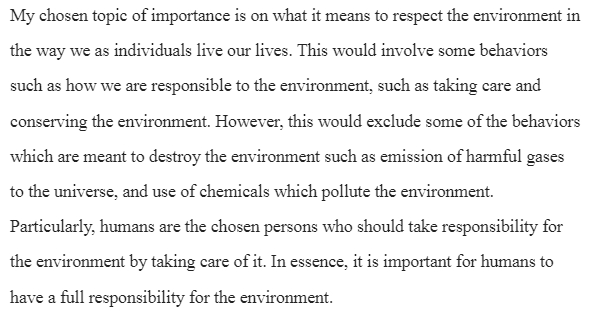Applied Ethics-Environment Conservation
Please read these assignment instructions before writing your paper, and re-read them often during and after the writing process to make sure that you are fulfilling all of the instructions.
Overview
In the Week One Assignment, you chose a concrete moral question, identified three ethically significant issues that pertain to that question, and constructed a thesis statement that articulated your position on that question. In the Week Three Assignment, you discussed either deontological or utilitarian theory, applied that theory to the topic, and raised a relevant objection.
By engaging with the course material, you now have had a chance to refine your thinking and broaden your understanding of the issue by approaching it from the perspective of multiple ethical theories.
In this paper, you will demonstrate what you have learned by writing an essay in which you
- Present a revised thesis statement on the question you are discussing.
- Identify, explain, and apply the core principles of at least two ethical theories to draw specific moral conclusions about the question you are discussing.
- Present your own reasoning on the question you are discussing and explain which of the ethical theories best supports your own view on the issue.
Instructions
Write an essay that conforms to the requirements below. The paper must be 1500 to 2000 words in length (excluding the title and reference pages) and formatted according to APA style as outlined in the Ashford Writing Center.
The paragraphs of your essay should conform to the following guidelines:
Applied Ethics-Environment Conservation-Introduction (150 to 200 words):
Your first paragraph should introduce the topic by briefly and precisely discussing the concrete problem or question that you will be addressing, including a brief preview of the ethically significant issues that make this question important. This should draw upon your work in the Week One Assignment, but should be more succinct and reflect the development of your understanding of those ideas throughout the course.
Conclude your introductory paragraph with the revised statement of your thesis, and a brief description of the primary reason(s) supporting your position. (If you changed topics, you will need to repeat the exercises from the Week One Assignment, including using the Thesis Generator from the Ashford Writing Center. Please see the notes and guidelines for more on this).
Application of Two Ethical Theories (1000 to 1200 words):
This section of the Final Paper consists in explaining and applying the core principles of two ethical theories to the question or problem you have chosen. One of these theories may be the theory you used in your Week Three Assignment, but your discussion here should be more refined and must identify the specific moral conclusions(s) that result when the theory is applied to the question or problem you are addressing.
For each of the theories you are considering, you should
Explain the core principles or features of the theory and the general account of moral behavior it provides.
Explain how these principles or features apply to the problem or question under consideration and identify the specific moral conclusion that results when these theories are applied to that problem or question.
A specific moral conclusion is a statement that takes a moral stance on the issue at hand. For example, if you’re discussing the question, “Is the death penalty moral?” a discussion that identifies and applies the core principles of utilitarian theory might yield the specific conclusion that the death penalty is moral because it ensures the greatest good for the greatest number. Applying virtue ethics might conclude that the death penalty exhibits the vice of cruelty, or a deontological theory might worry that it fails to treat the criminal as an end-in-itself. (Note: These are just examples; you may not write on the death penalty, nor is it necessarily the case that each theory would lead to the conclusion mentioned).
For purpose of this assignment, it’s best if you explain its core principles and moral conclusion(s) and apply one theory first and then turn to the second theory. This section of the paper should be approximately 1000 to 1200 words (500 to 600 words for each theory application).
Evaluation (150 to 300 words):
In this section of the paper, you should explain which ethical theory you think presents the most persuasive moral argument on this question and why. Then briefly address a common objection to that argument that you have not yet considered in the main part of your paper, and provide a concise response to that objection.
For example, if you were writing on capital punishment, you might think that a utilitarian argument that defends position X is most persuasive. You would then raise an objection against a utilitarian defense of position X, and defend that view against the objection.
Conclusion (150 to 300 words):
Provide a conclusion that sums up what you presented in the paper and offer some final reflections, including a revised statement of the thesis (do not simply repeat your thesis, but rephrase it in light of the discussion you just presented).
Answer Preview-Applied Ethics-Environment Conservation

